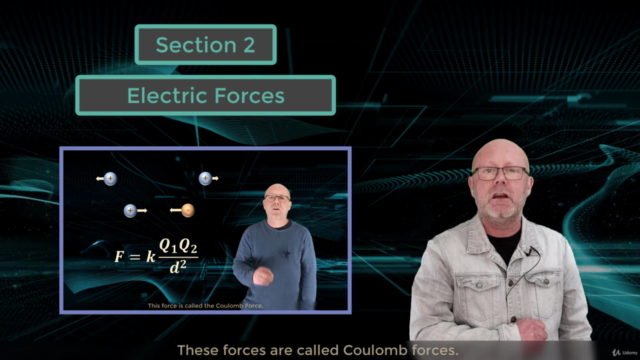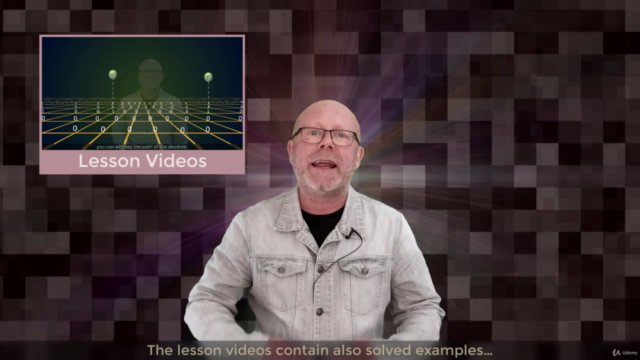Electricity, The Basics: Charges, Forces & Fields (Physics)
A Detailed Review of the Fundamentals of Electrical Sciences (Electric Charges, Electric Forces and Electric Fields)
4.70 (119 reviews)

629
students
3 hours
content
Apr 2020
last update
$19.99
regular price
Why take this course?
Based on the outline provided for the course "Electric Charges, Electric Forces and Electric Fields," here is a detailed breakdown of the topics covered in each section along with a brief explanation of what each lecture or exercise entails:
SECTION 1: Electric Charges
- Introduction: A general overview of what electric charges are and their importance in the field of physics.
- What is a charge?: Exploring the concept of electric charge, its nature, and types (positive and negative).
- Quantifying a charge: Learning how to measure electric charge using Coulomb as the unit of measurement.
- Conservation of charge: Understanding that electric charge cannot be created or destroyed, only transferred.
- Interactions between charges: Investigating how charges interact with each other and the forces involved.
- Electric currents: Exploring the movement of charges through a conductor.
- Conductors and insulators: Discussing materials that can and cannot conduct electric charge.
- Static electricity magic: the aluminium can: A practical demonstration of static electricity and its effects on a charged aluminium can.
- Static electricity magic: the soap bubble: Exploring the formation of soap bubbles under static electric fields.
- Full definition of an electric charge: Summarizing and solidifying the understanding of what an electric charge is.
- Electric charges - quiz video: Testing knowledge on the topics covered in this section through a quiz format.
SECTION 2: Coulomb’s Law (Electric Forces)
- Introduction: Setting up the context for understanding electric forces.
- Lesson: A detailed explanation of Coulomb's Law, which describes the electrostatic force between two point charges.
- Exercise 1 – Direct application of Coulomb’s Law: Applying Coulomb's Law to solve problems involving two charges.
- Exercise 2 – Position of balance between two charges: Finding the equilibrium position for two charged particles.
- Episode 4: Exercise 3 – Coulomb’s law in 2 Dimensions: Extending the application of Coulomb's Law to two-dimensional scenarios.
- Exercise 4 - Exam level Problem: Solving an advanced problem that could appear on an exam, involving multiple charges and their forces.
SECTION 3: Electric Fields
- Introduction: Introducing the concept of the electric field and its significance.
- What is an electric field?: Defining the electric field and its relationship with electric forces.
- Electric field strength (part 1): Discussing how to calculate the strength of an electric field.
- Electric field strength (part 2): Continuing the discussion on calculating the electric field strength, possibly with practical applications.
- Exercise 1 – Charged sphere in an electric field: Analyzing the electric field around a charged sphere.
- Exercise 2 – Electric field of a proton in an hydrogen atom: Calculating and understanding the electric field generated by a proton in a hydrogen atom.
- Exercise 3 – Deriving Coulomb’s Law from electric fields.: Using the concept of electric fields to derive Coulomb's Law.
- Electric field strength vectors in 1D: Visualizing and working with electric field vectors in one dimension.
- Exercise 4 – Position of balance between 2 electric charges: Determining the point at which two electric charges will balance each other out.
- Electric field strength vectors in 2D: Exploring the complexity of electric fields in two dimensions.
- Exercise 5 – Multiple electric fields in 2 dimensions.: Solving problems involving multiple electric fields overlapping in two dimensions.
- Electric field lines: Understanding how to represent electric fields using field lines.
- Radial & uniform fields: Investigating electric fields that are uniform and radiate out from a point or charged object symmetrically.
- Exercise 6 – Motion of a charge between two charged parallel plates: Analyzing the motion of a charge placed between two charged parallel plates, which can lead to interesting phenomena like dielectric breakdown.
This course provides a comprehensive understanding of electric charges, the forces they exert on each other, and how these forces manifest as electric fields. The combination of theoretical explanations, practical exercises, and quizzes ensures a solid grasp of the fundamental concepts in electromagnetism.
Course Gallery




Loading charts...
Related Topics
3063556
udemy ID
28/04/2020
course created date
21/05/2020
course indexed date
Bot
course submited by